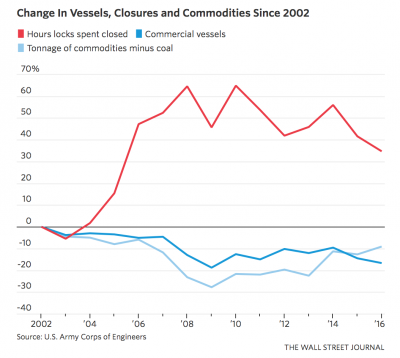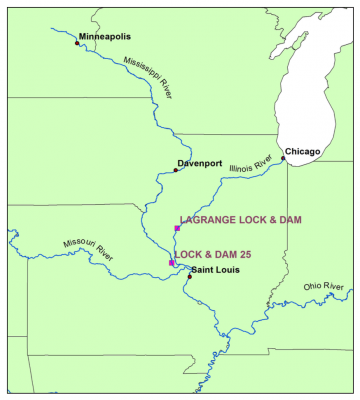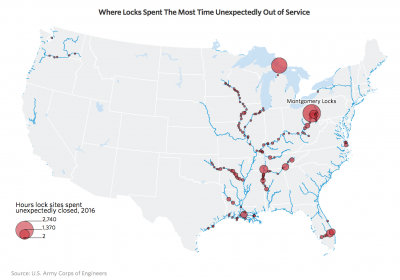“‘If we have a barge stopped on the Upper Mississippi…commodities sit there until the problem is fixed,’ says Rick Calhoun, president of Cargill Carriers, the Minnetonka, Minn.-based barge operator for the largest U.S. agricultural company by sales. ‘There’s no detours, there’s no way to do much but wait. And waiting costs a lot of money.’
Infrastructure: Aging River Locks in the Corn Belt Prove Costly
In an update last week at The Wall Street Journal Online (“Disaster Looms on America’s Waterways“), Shane Shifflett reported that, “For American producers who rely on the nation’s waterways to export and distribute billions of tons of grains, coal and chemicals each year, aging locks systems on rivers and the frequent delays they cause cost more than just time.
Locks help ships navigate uneven and inconsistent water levels, acting as an elevator of sorts. With sudden outages becoming more common, the cost to producers—and ultimately consumers, in the form of higher prices for food and other goods—is rising.
Mr. Shifflett explained that, “Nearly 80% of lock sites with commercial traffic, most of which are older than their intended 50-year lifespan, had an unexpected outage in 2016. That’s up from 71% in 1993, according to a Wall Street Journal analysis of U.S. Army Corps of Engineers data. The average delay, meanwhile, increased 54 minutes to 144 minutes in 2016 compared with 1993.
“That’s pushed some shipping companies to move more traffic off river. The tonnage of commodities shipped through locks, excluding coal, fell nearly 13% between 2002 and 2015 to 1.7 billion tons. By contrast, the combined shipments of goods via truck and rail, excluding coal, grew by 3.1% to more than 11.8 billion tons, according to data from the Army Corps and Federal Highway Administration.”

The Wall Street Journal article pointed out that, “In an analysis of 20 Pennsylvania locks, the Port of Pittsburgh Commission, a state-funded agency, estimated that diverting 5% of barge traffic to trucks would increase shipping costs by nearly $200 million.
But with the network of dams and locks that make commercial river traffic possible at risk of failure after decades of underinvestment, producers face a tough choice.
“A 2016 study by the University of Tennessee analyzing the effects of lock outages estimated that closures at one particular lock on the Mississippi River would cause shipments of corn and soybeans to decline 9%. A closure during the key fall harvest could reduce exports by 5 million tons, the study found. Authors Edward Yu, Burton English and R. Jamey Menard estimated that a significant decline in corn and soybean shipments could cause a $2.4 billion loss of economic activity.”
More specifically, the 2016 study (“Economic Impacts Analysis of Inland Waterways Disruption on the Transport of Corn and Soybeans“) indicated that, “The Upper Mississippi River-Illinois River (UMR-IR) is a primary corridor for U.S. grain and oilseeds to Gulf of Mexico export ports. The U.S. Army Corps of Engineers (USACE or Corps) maintains a 9-foot-deep navigation channel for barge transportation on a total of 36 locks and dams, including 28 on the UMR and 8 on the IR. Built in the 1930s, most of these locks have surpassed their designed lifespan. However, maintenance and rehabilitation efforts by the Corps have extended the life cycle of many of the projects. Nevertheless, the U.S. grain and oilseed industry has frequently raised concerns about the navigational efficiency of these aging and constrained waterways. Congress authorized the Navigation and Ecosystem Sustainability Program (NESP) in 2007 to address the capacity constraints on the most congested segments of the UMR-IR. However, the implementation of NESP has been delayed due to a lack of pre-construction and construction appropriations from Congress.”
The authors of the study explained that, “The hypothetical disruptions used for the study are lock closures at Mississippi River Lock 25 and Illinois River La Grange Lock, since these two locks are the only two included in both modernization on and small-scale navigation improvement under NESP. These locks were also selected because they have a smaller capacity chamber of only 600 feet; and because they are older than the remaining two southernmost locks on the Mississippi River in the St. Louis area.”

The report noted that: “The closure of Lock 25 during harvest season from September to November—with rail rates remaining unchanged—resulted in corn and soybean prices in Illinois, Iowa, and Minnesota (adjacent to the UMR) decreasing up to $4.89/ metric ton (mt) ($0.13/bushel (bu)) and $8.25/mt ($0.22/bu), respectively.
“When the horizon of the lock closure extends to 1 year, corn prices in the regions next to the river decrease $6.61/mt ($0.17/bu) and the soybean prices decline up to $10.81/mt ($0.29/bu) if rail rates remain steady.
“The producer prices of corn and soybeans drop further when rail rates increase and Lock 25 is inaccessible for a year, with prices reducing up to $8.15/mt ($0.21/bu) for corn and $16.33/mt ($0.44/bu) for soybeans.”
Very interesting set of graphics from the @wsj- "Disaster Looms on America’s Waterways," https://t.co/1RMW5c7aLK by @shaneshifflett pic.twitter.com/8La80ofiNk
— Farm Policy (@FarmPolicy) July 28, 2017
Last week’s Wall Street Journal article stated that, “While there are currently 25 projects to upgrade and rehabilitate various locks and canals around the country, they still require $8.7 billion to complete. Delays in funding over the years have caused at least one project to be extended over a decade beyond its original end date.”

Mr. Shifflett added that, “In June, President Donald Trump recognized the fraught state of waterway infrastructure—which carry about 14% of the nation’s domestic freight—during a speech in Cincinnati. He promised ‘to create the first class infrastructure our country and our people deserve.’ Still, his latest budget proposal cuts the Army Corps budget by 16% compared with funds appropriated by Congress last year. An earlier White House budget document outlining 2018 spending priorities called for a higher tax on barges and boats to increase the balance.”





